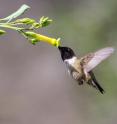Looking different than your parents can be an evolutionary advantage
RIVERSIDE, Calif. -- Looking different to your parents can provide species with a way to escape evolutionary dead ends, according to new research from Queen Mary University of London (QMUL) and the University of California, Riverside. The work, which is outlined in a paper published today (August 8) in the journal Nature Plants, looked at polyploid hybrids in the genus Nicotiana, the group that includes tobacco.
Unlike humans, which are diploids - with two copies of each of their 23 chromosomes (one from each parent) - polyploids can have three, four or more copies of each chromosome. This makes them particularly prone to producing hybrids and - in contrast to better-known hybrids such as the mule (the sterile product of a cross between a male donkey and a female horse) - means that crosses between polyploids are often fertile.
While hybrids might be expected to be a blend of the two parent species, the researchers found that they tended to have shorter and wider flower openings than both of the parent species which means that a wider range of pollinators can enter the flowers.
By allowing a wider range of insects to pollinate them, hybrids make themselves much less vulnerable to the extinction of a single pollinator.
Elizabeth McCarthy, who carried out the work as part of her Ph.D. at QMUL and is now a post-doctoral researcher at UC Riverside, said:
"Some plants evolve increasingly specialized relationships with the species that pollinate them. A classic example is Darwin's Madagascan orchid, first discovered in 1798. Its exceptionally long nectar spur led Charles Darwin to propose that it was pollinated by a moth whose proboscis - the organ that extracts the nectar - was longer than that of any moth known at the time. Darwin's prediction was spectacularly verified 21 years after his death when just such a moth was discovered."
The problem with this sort of specialized relationship - which we now term coevolution - is that if one of the two species involved becomes extinct, the other is also doomed.
Source: University of California - Riverside
Articles on the same topic
- Looking different to your parents can be an evolutionary advantageTue, 9 Aug 2016, 9:10:36 UTC
Other sources
- Looking different to your parents can be an evolutionary advantage, at least in plantsfrom Science DailyTue, 9 Aug 2016, 9:02:26 UTC
- Looking Different to Your Parents Can Be an Evolutionary Advantagefrom Newswise - ScinewsMon, 8 Aug 2016, 17:32:00 UTC
- Looking different to your parents can be an evolutionary advantagefrom PhysorgMon, 8 Aug 2016, 15:31:55 UTC
